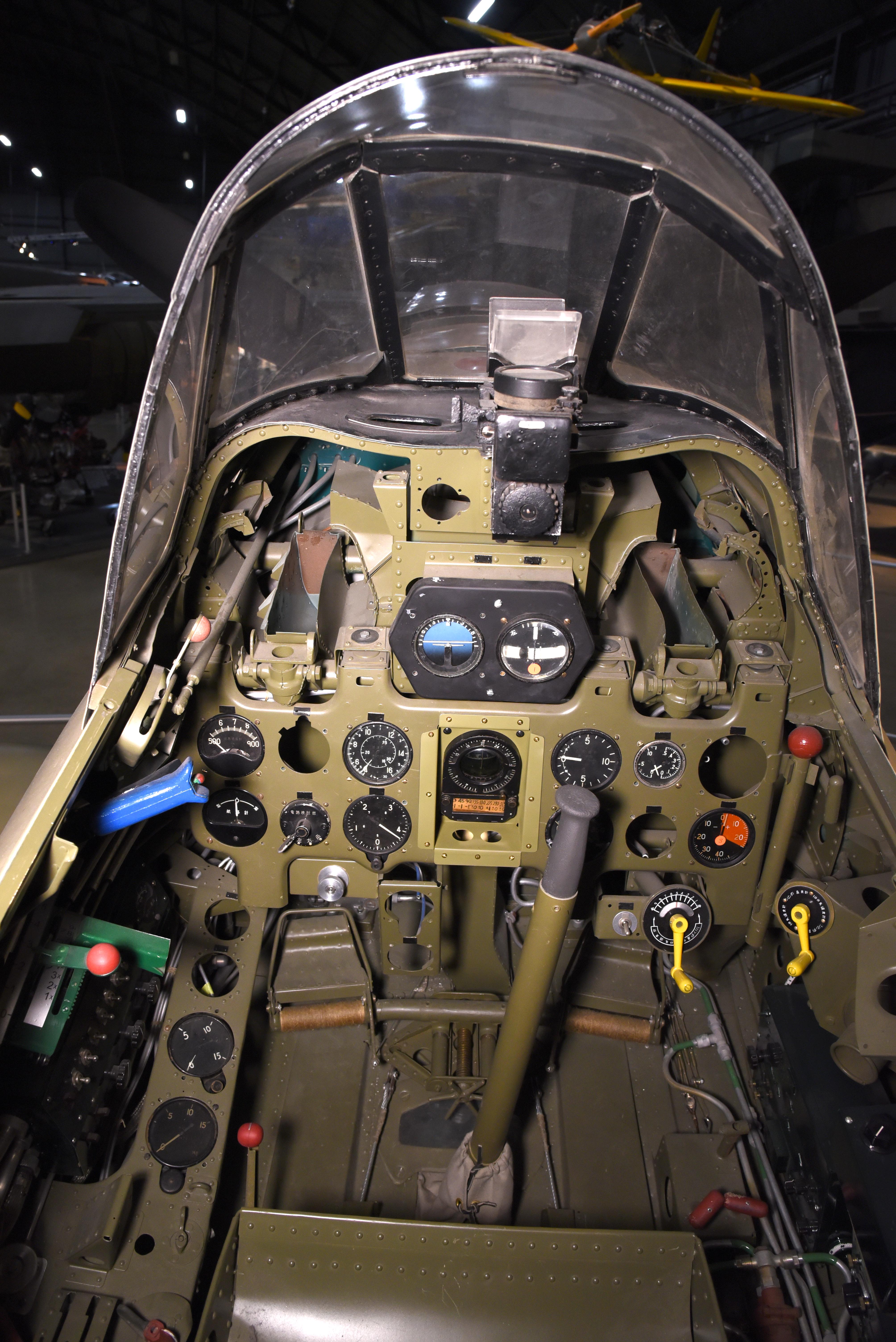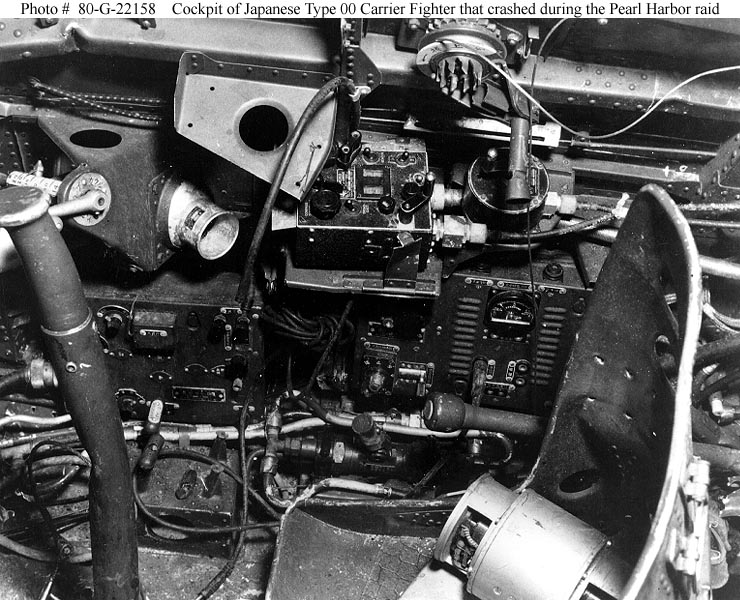Cockpit Of A Japanese Zero Airplaine Inside A Hold Of The Fujikawa Maru

More Zero-Sens were produced than any other wartime Japanese aircraft. Mitsubishi alone produced 3,879 aircraft of this type, and Nakajima built 6,215. Altogether, with the 844 trainer and floatplane variants produced by Sasebo, Hitachi and Nakajima, production of the A6M series aircraft totaled 10,938 aircraft.
Mitsubishi A6M2 Zero > National Museum of the US Air Force™ > Display

This contains a photograph of the aircraft in formation over Malaya with the other Zero sent to Australia for museum purposes (BI-12, an A6M2). Thanks to John White of the Australian War Memorial. Hardcopy file information (email comm.) suggests that the aircraft was part of 381 Air Wing, Imperial Japanese Navy.
Mitsubishi A6M2 Zero

Description. Mitsubishi A6M2 single engine, single seat, cantilever low wing monoplane fighter aircraft of all metal construction. The tail control surfaces are fabric covered. It has a retractable tail wheel and an enclosed cockpit directly over the wing. The wingtips fold for stowage aboard an aircraft carrier.
Cockpit view of the instrument panel of the Japanese Zero fighter

Design and development. The A6M2-N floatplane was developed from the Mitsubishi A6M Type 0, mainly to support amphibious operations and defend remote bases. It was based on the A6M-2 Model 11 fuselage, with a modified tail and added floats. A total of 327 were built, including the original prototype.
零式艦上戦闘機, 戦闘機, 戦闘機 パイロット

Well Gunze do both Mitsubishi and Nakajima cockpit Greens in their lacquer ranges (the ones that are coded C not H). Both are quite dark, much darker than any of the Allied Greens used in cockpits. They also do a Cowling Blue/Black colour which has a nice tint to it for the engine cowlings and rear turtle deck, which should be the blue/black colour, not Green should also be raised rivets not.
Defense Strategies Mitsubishi A6M Zero Was A Fury

When Japan attacked Pearl Harbor on Dec. 7, 1941, 125 Zeros from six aircraft carriers participated. In the early part of the war, Allied aircraft such as the Curtiss P-40 and Seversky P-35 were at a disadvantage in a dogfight with a Zero flown by a skilled pilot, and the A6M became a well-known and dangerous opponent.
Japanese Zero Cockpit stock photo. Image of flight, pilot 66745792

WHEN THE UNITED States Navy entered the war with Japan, it did so with the Grumman F4F Wildcat as its principle frontline carrier-based fighter - a warplane that, at least on paper, was greatly outclassed by Japanese Mitsubishi A6M Zero. The actual numbers tell a different story.
"Cockpit of a Mitsubishi Zero" by Mike Edwards Redbubble

Zero chief designer Jiro Horikoshi assembled a team in 1937 to design a new fighter for the Imperial Japanese Navy with two primary goals in mind: to make the aircraft as maneuverable as possible and to provide it with enough range to escort Japanese bombers all the way to distant targets in China and back.
Japanese Zero cockpit Fujikawa Maru Truk Lagoon Underwater

On page 129 of Robert Mikesh's 'Japanese Cockpit Interiors 1940 -1945' is a photo that shows the mounts for the radio systems quite clearly. Zero Cockpit - Left View. Photo Credit: Hickam Base Photo Lab via LRA. Zero Cockpit - Right View. Photo Credit: Hickam Base Photo Lab via LRA . Drawing number 1 shows the face of the transmitter.
The Pacific War Online Encyclopedia A6M "Zero", Japanese Carrier Fighter

The Mitsubishi A6M " Zero " is a long-range carrier-based fighter aircraft formerly manufactured by Mitsubishi Aircraft Company, a part of Mitsubishi Heavy Industries, and was operated by the Imperial Japanese Navy (IJN) from 1940 to 1945.
Pin on Cockpits

The Museum's A6M5 Zero was license-built by the Nakajima Aircraft Company in Oizumi, Gunma, Japan in May 1943. It entered service in July 1943 with the 261st Kokutai (Air Group), where it most likely flew patrols over Nagasaki on the Japanese island of Kyushu. In October 1943, it was sent to Iwo Jima. In March 1944, it transferred to Saipan.
제2차 세계대전 일본 함상전투기 미츠비시 A6M 제로(Zero) 스토리 네이버 블로그

Mitsubishi A6m Zero stock photos are available in a variety of sizes and formats to fit your needs.
cockpit of a Japanese Mitsubishi A6M3 Papua 1943 2 World War Photos

The design of the A6M Zero began in May 1937, shortly after the introduction of the Mitsubishi A5M fighter. The Imperial Japanese Army had commissioned Mitsubishi and Nakajima both to build the planes.
1000+ images about WWII Japanese Mitsubishi Zero on Pinterest Planes

Explore A Mitsubishi A6M2 Zero fighter cockpit Smithsonian's National Air and Space Museum Washington, DC, United States Japanese crafts persons built the Zero control stick out of the.
japanese Zero fighter cockpit by Sceptre63 on DeviantArt

Zero Restored Japanese Mitsubishi A6M2 Zero fighter. The Zero was made by Mitsubishi Heavy Industries and was first powered by a Nakajima Sakae radial air-cooled engine of 14 cylinders (two staggered rows of seven) that developed 1,020 horsepower. Later it used a 1,130-horsepower engine to turn its three-blade constant-speed propeller.
Mitsubishi A6M2 Zero

One of the most famous planes of the Second World War, the Mitsubishi A6M Zero-Sen, was Japan's best fighter and the bane of Allied airmen in the Pacific. Rigorous Specifications The Zero was designed to meet a tough set of specifications set down by the Japanese Navy in 1937.